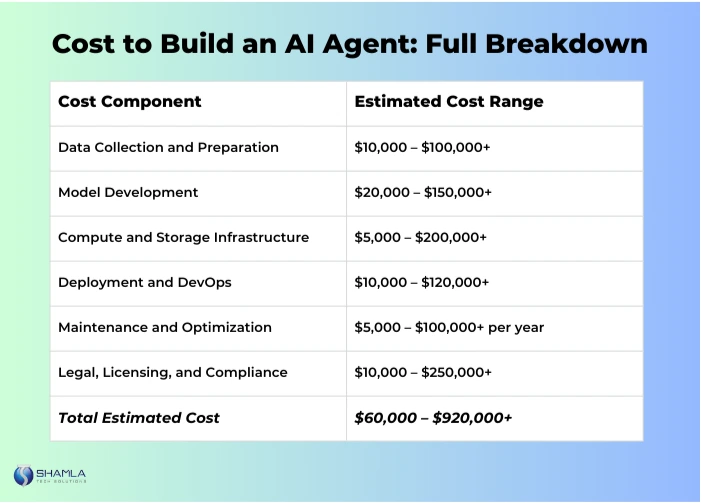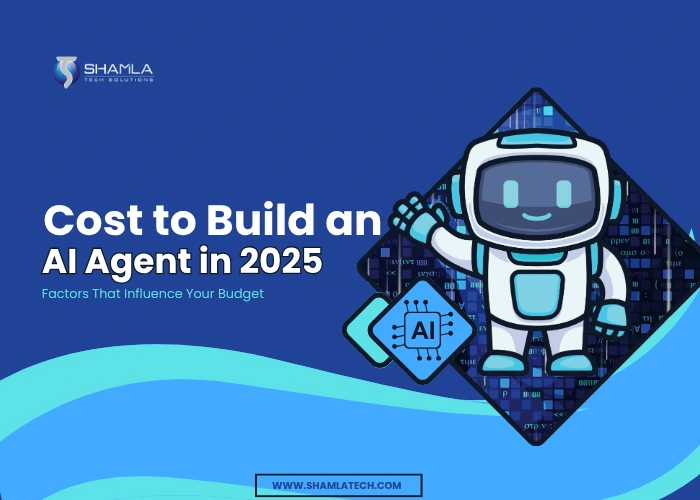Building an AI agent can range in expense from as little as $20,000 to well beyond $500,000, depending on complexity and requirements
Key expenses include collecting and cleaning data ($5,000 – $50,000), training models on cloud servers ($10,000 – $200,000), writing and testing code ($15,000 – $150,000), and setting up security and hosting ($5,000 – $50,000). You may also spend on licensing third-party tools ($2,000 – $30,000) and ongoing support ($1,000–$20,000 per month)
Knowing these figures helps startup founders, developers, and business planners set realistic budgets and avoid surprise bills when they build chatbots, recommendation systems, or other AI applications.

Cost to Build an AI Agent: Full Breakdown
1. Gathering and Organizing Data – $10,000 to $100,000+
Data underpins every AI system; without rich datasets, models underperform. You can source public data at no cost, though it often lacks depth. Proprietary datasets deliver quality but carry license fees from $5,000 to $50,000. Choosing open or paid sets affects your cost to build an AI agent. Evaluate dataset size, format, and update frequency before purchase. Factor in storage fees on cloud drives. Budget for data discovery tools like web scrapers or API services, which add $1,000-$10,000. Planning data sourcing early prevents scope creep and surprise bills.
Labeling raw data demands human insight, especially in niches like medical imaging or legal docs. You can hire freelance annotators at $0.05–$0.20 per label, or use in-house staff at $30–$60 hourly. Annotation platforms with built-in quality checks cost $2,000+ monthly. In outsourcing, verify label accuracy through spot checks to avoid model drift. In-house teams gain domain context but raise payroll costs. Include project management overhead when scaling annotation. Effective labeling strategy directly impacts AI agent development success
Once data arrives, cleaning removes errors like duplicates, missing values, or format mismatches. Automated scripts in Python or SQL handle basic fixes, costing $5,000-$15,000 in developer hours. For complex tasks, use ETL platforms that charge $0.10-$0.50 per transaction. Preprocessing steps such as normalization, tokenization, or encoding prepare data for model input. Logging and monitoring pipelines ensure issues are caught early. Investing in robust workflows reduces debugging time during training. Allocate time for iterative refinement, skipping it can inflate downstream compute costs.
Handling user data triggers legal checks to comply with GDPR, HIPAA, or CCPA. Privacy audits and policy drafts require lawyers at $200-$400 hourly. Data protection tools like encryption services cost $1,000-$5,000 upfront plus $100 monthly. Noncompliance fines can exceed $20,000 per breach, so budget for regular audits. Security reviews, including pen tests on storage systems, add another $3,000–$10,000. Compliance planning avoids stoppages and reputational damage.
Key Steps in Data Gathering and Preparation
- Dataset sourcing: Compare free public sets vs. paid proprietary ones; check license terms and quality.
- Annotation strategy: Define clear label guidelines; choose in-house or outsourced teams based on scale and budget.
- Data cleaning: Use ETL scripts to dedupe, fill gaps, and standardize formats before training.
- Validation pipeline: Implement schema checks and anomaly detection to catch errors early in workflows.
- Preprocessing tasks: Normalize values, tokenize text, and encode categories to ready data for models.
- Compliance measures: Deploy encryption, consent tracking, and regular audits to meet GDPR/HIPAA rules.
2. Model Development - $20,000 to $150,000+
Deciding whether to use a ready-made model or create one from the ground up depends entirely on your goals and how much you can spend. Adopting a pre-trained transformer like GPT or BERT cuts development time and hosting costs. Training a model from zero demands large compute clusters, custom layers, and heavy tuning. Weigh the cost to build an AI agent using an existing backbone against the hours spent coding new architectures. For niche tasks, fine-tuning a base model often hits performance targets faster. Always benchmark both paths on sample data before committing to a full training run.
Recruiting the right team drives project speed and quality. Many teams ask: how to build an AI agent. The simple answer is that you need machine learning engineers to write training scripts, data scientists to design features, and MLOps experts to automate pipelines. Salaries range from $100K to $200K per year per role. Large projects often split roles for parallel work. Factor in contractor fees if you lack full-time hires. Clear role definitions prevent task overlap and wasted hours
Designing and testing algorithms eats up time and budget. Setting up loss functions, regularization, and hyperparameter sweeps can take weeks. Each training cycle on GPU clusters may cost $5 to $50 per hour, depending on instance type. Running ten trials to find optimal learning rates or batch sizes easily adds $1,000–$10,000. Use automated tools like Ray Tune or Optuna to streamline searches. Log results in tools such as MLflow to avoid repeat tests. Cutting redundant experiments saves compute costs and speeds delivery.
Deciding between custom code and off-the-shelf tools affects both control and spend. Building custom layers or novel attention mechanisms gives full flexibility but requires senior engineers and extra debug time. Using open-source libraries like TensorFlow or PyTorch avoids license fees but may need more in-house support. Premium SDKs from cloud vendors include built-in monitoring, costing $0.10–$0.50 per API call but reduce maintenance work. Balance licensing fees against developer hours. A clear integration plan keeps the model stable in production.
Key Steps in Building the Model
- Assemble team: Define machine learning, data science, and MLOps roles to cover all development stages.
- Estimate compute: Calculate GPU/TPU hours for training cycles and factor cluster costs into budgets.
- Automate tuning: Use hyperparameter tuning frameworks to optimize learning rates, batch sizes, and architectures.
- Manage code: Choose between open-source libraries and paid SDKs by weighing license fees against support needs.
- Plan deployment: Build CI/CD pipelines for model serving, monitoring, and rollback to ensure production stability.
3. Computing Power and Storage - $5,000 to $200,000+
Training AI models means doing millions of big calculations. Each step, forward pass, backward pass, and weight update, runs on GPUs or TPUs for hours or days. Standard GPU instances cost about $3–$6 per hour, while top-end units run $8–$15 per hour. For a medium model, you might spend $10,000–$30,000 just on compute time. The cost to build an AI agent often hinges on these rental fees. Planning your training runs and reusing checkpoints cuts wasted cycles and keeps bills in check.
Cloud providers rent GPUs and TPUs by the hour. On-demand prices are easy to start with but run highest; spot or preemptible instances cut rates by up to 70% at the risk of interruptions. Reserved plans lock in lower hourly fees but need one-year or three-year commitments. Balancing instance type, availability zone, and pricing plan can save thousands without slowing training.
Storing datasets and model files grows costly at scale. Raw data and processed features live in object storage like AWS S3, GCP Cloud Storage, or Azure Blob, charging $0.02–$0.03 per GB monthly. Hot tiers serve active training data; cold tiers hold backups at $0.004 per GB. Model checkpoints also store at similar rates. Local servers avoid rental but need hardware purchase ($10,000+ for a storage node) and ops staff. Factor in data transfer fees, usually $0.01–$0.05 per GB egress, to predict total spend.
As user demand grows, you must scale compute and storage together. Auto-scaling groups spin up new instances when load spikes, then scale down when idle. Each new GPU adds rental and storage I/O costs, so test your scaling rules to avoid surprise charges. Small projects may spend $5,000–$20,000 monthly, while large enterprises can hit $50,000–$200,000 or more. Monitoring tools track usage in real time, letting you cap resources and set alerts before bills skyrocket.
Key Aspects of Compute and Storage
- Instance selection: Choose GPU vs. TPU based on model size and compute needs.
- Pricing models: Blend on-demand, spot/preemptible, and reserved instances to optimize hourly costs.
- Storage solutions: Use hot storage for active data and cold storage for backups to minimize monthly expenses.
- Data migration: Be mindful of egress fees when transferring data between regions or to users.
- Auto-scaling rules: Define clear thresholds to add or remove compute nodes without overshooting budgets.
- Monitoring and alerts: Set up cost and usage alerts to catch unexpected spikes in real time.
4. Infrastructure and Deployment - $10,000 to $120,000+
Setting up the backend means creating APIs, packaging code in containers, and managing services. Use REST or gRPC endpoints to handle requests. Docker containers isolate your app, while Kubernetes manages scaling and failover. Infrastructure as code tools like Terraform let you spin up servers the same way every time. Service meshes such as Istio or Linkerd control traffic and retries. Considering the cost to build an AI agent, choosing these tools early cuts later rework.
To serve an intelligent AI agent reliably, pick between shared, virtual private, or dedicated hosts. Continuous integration and deployment speed up code releases. Add test suites like pytest or unittest to catch bugs early. Store build artifacts in registries such as Docker Hub or AWS ECR. Deploy with Helm charts or Terraform scripts. Monitoring tools, Prometheus, Grafana, or the ELK stack, track performance and logs. If a deploy fails, rollback steps restore the last good version without downtime
Keeping the system fast and safe takes ongoing effort. Use autoscaling rules to add or remove servers based on CPU, GPU, and memory use. Add rate limits and circuit breakers to stop overloads. Enforce TLS, IP whitelists, and web application firewalls for security. Run regular patch updates and vulnerability scans. Rapid prototypes can run on a single node, saving initial spend but risking outages. Production-grade systems need multi-zone clusters, full CI/CD checks, and high-availability databases, raising engineering work and hosting fees.
Key Steps in Infrastructure and Deployment
- Backend architecture: Map out API endpoints, container images, and service patterns up front.
- Environment provisioning: Automate server, network, and service setup with infrastructure as code.
- Hosting selection: Weigh shared, virtual private, and dedicated options by cost and performance.
- Deployment pipelines: Build CI/CD flows that run builds, tests, and rollbacks without manual steps.
- Monitoring and alerts: Collect metrics and logs, then set alerts to catch issues early.
- Security and scaling: Apply encryption, access controls, and autoscaling rules to stay up and safe.
5. Ongoing Maintenance and Optimization - $5,000 to $100,000+ per year
Models lose accuracy over time as real-world data shifts, a problem called model drift. Schedule updates every quarter or when new data appears. Track simple scores like accuracy and precision before each release. Budget extra compute for these cycles, small updates often use 10–20% of initial training hours. Breaking out these costs helps teams see where money flows and avoid surprise hosting bills, aligning with cost to build an AI agent plan.
Track how your system behaves in production by capturing key signals: response time, error rates, and user feedback. Send logs to a central store, then use dashboards to spot spikes. Alert on slow queries or failed calls so engineers can act fast. Record user inputs and model outputs (with privacy filters) to study edge cases. This continuous view lets you catch issues early and keeps the AI reliable for end users.
Some models generate wrong or unsafe replies, called hallucinations. Detect these by running test prompts and flagging odd answers. Use rule-based checks or small review teams to catch bad outputs. When you find errors, add corrective labels to your dataset and retrain the model. Keep a lookup table of banned words or phrases to block unsafe content. Regular audits by human reviewers stop bad behavior before it reaches customers.
Retraining on new data needs fresh compute and storage. Plan for monthly or biweekly cycles, depending on data volume. Each retraining run on GPUs may cost $2,000–$10,000. Automate the trigger when performance dips below thresholds you set. Human oversight is vital: support engineers fix live bugs, AI ethicists review fairness and bias, and quality control tests new versions. As AI agents will transform the future of work, these roles ensure your system stays safe, fair, and useful
Key Tasks in Maintenance and Optimization
- Scheduled updates: Plan version releases on a regular cadence to prevent model drift.
- Performance monitoring: Capture metrics like latency, error rates, and user satisfaction in real time.
- Interaction logging: Store anonymized user queries and replies for audit and improvement.
- Hallucination control: Implement rule checks and human reviews to detect and fix bad outputs.
- Retraining cycles: Automate retraining triggers based on performance dips and new data availability.
- Human oversight: Assign support engineers, ethicists, and QA teams to maintain safety and quality. </ul
6. Legal, Licensing, and Compliance - $10,000 to $250,000+
Commercial AI APIs and datasets often charge per call or by subscription tiers. Pay-as-you-go models bill $0.0001–$0.01 per request, while enterprise plans start at $10,000 annually. Volume discounts kick in above one million calls. Dataset licenses may carry one-time fees from $5,000 to $100,000 depending on data quality and exclusivity. Open-source sets cut fees but require vetting for use restrictions. Factoring these charges into your cost to build an AI agent upfront prevents budget shortfalls later applying to several real-life AI agent examples.
Intellectual property rules determine who owns model outputs. Terms of service for engines like OpenAI or Cohere specify user vs. vendor rights. Custom code and annotated data often belong to your organization, but third-party components may require attribution or share-alike licensing. Patenting novel algorithms can cost $10,000–$20,000 in legal fees and filing costs. Review contributor agreements if you integrate community models. Keeping clear records of provenance and licensing streams safeguards your AI agent from infringement claims.
Certain sectors demand strict compliance. Finance bots need SEC disclosures, audit trails, and data retention for seven years. Healthcare agents processing PHI must follow HIPAA: encrypt data in transit and at rest, maintain access logs, and have a breach response plan. Manufacturing or energy systems may require NIST or ISO 27001 certification. Compliance consultants charge $150–$300 per hour, and certification audits start at $20,000. Automated policy-enforcement tools simplify rule checks but add licensing fees.
Misuse of AI can lead to defamation, privacy, or bias lawsuits. Legal defense budgets range from $50,000 to $250,000 per case. Purchasing AI liability insurance costs $5,000–$25,000 annually, covering claims for faulty outputs or data breaches. Retain counsel familiar with technology law for ongoing advice; hourly rates are $300–$600. Regularly update your terms of service and privacy policy to reflect new risks. A clear indemnity clause with partners limits exposure if third-party data or code causes legal issues.
Key Points in Legal, Licensing, and Compliance
- API licensing: Evaluate per-call, subscription, and enterprise fee structures for serving AI models.
- Dataset licenses: Check usage rights, exclusivity clauses, and renewal fees before acquiring data.
- IP ownership: Define rights in user agreements; patent unique methods and track component origins.
- Regulatory audits: Budget for sector-specific certifications (SEC, HIPAA, ISO) and external consultant hours.
- Litigation risk: Model misuse can trigger lawsuits; allocate funds for defense and settlements.
- Insurance coverage: Secure AI liability policies to cover errors, breaches, and compliance failures.
Conclusion
Allocating the budget for the cost to build an AI agent yields high ROI through automated workflows, scalable data processing, and real-time insights. Improved prediction accuracy and reduced manual interventions optimize throughput and lower compute overhead. Investing in modular architectures and robust model pipelines delivers measurable revenue and operational efficiency gains.
Shamla Tech is a leading AI agent development company delivering cost-effective AI agent development services with end-to-end pipelines, model tuning, and secure deployment. Our expertise covers AI agent use cases like intelligent chatbots, predictive maintenance, and data-driven decision systems. Businesses gain faster time to market, enhanced customer engagement, and scalable automation, driving competitive edge and sustainable growth.
Contact us today to get a free consultation and a custom quote to Develop your AI Agent at an Affordable Cost!



